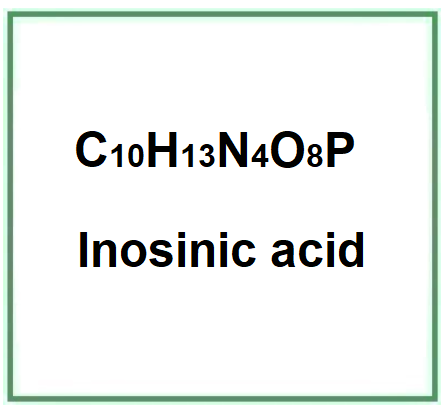Inosinic acid is a chemical compound, a dibasic acid, a ribonucleotide formed from adenine nucleotides by adenosine monophosphate deaminase that is found in the human body and in some bacteria.
What it is used for and where
Food
Ingredient included in the list of European food additives as E630 as a flavour enhancer to improve the taste of food and beverages (1).
Medical
Infants given milk fortified with nucleotides had a greater antibody response (2) and dietary nucleotides are believed to influence immune function (3).
Other uses
Food additive for animal feed (4).
- Molecular Formula C10H13N4O8P
- Molecular Weight 348.21 g/mol
- CAS 131-99-7
- UNII TAO7US05G5
- EC Number 205-045-1
References_____________________________________________________________________
(1) Liu, Z.Q., Zhang, L., Sun, L.H., Li, X.J., Wan, N.W. and Zheng, Y.G., 2012. Enzymatic production of 5′-inosinic acid by a newly synthesised acid phosphatase/phosphotransferase. Food chemistry, 134(2), pp.948-956.
(2) Pickering L.K., Granoff D.M., Erickson J.R., Masor M.L., Cordle C.T., Schaller J.P., Winship T.R., Paule C.L., Hilty M.D. Modulation of the immune system by human milk and infant formula containing nucleotides Pediatrics, 101 (1998), pp. 242-249
(3) Carver JD. Dietary nucleotides: cellular immune, intestinal and hepatic system effects. J Nutr. 1994 Jan;124(1 Suppl):144S-148S. doi: 10.1093/jn/124.suppl_1.144S.
Abstract. Investigations with animals demonstrate that dietary nucleotides influence immune function. Restriction of dietary nucleotides in mice decreases several indices of cell-mediated immunity as well as resistance to challenge with Staphylococcus aureus or Candida albicans. Spleen cells of mice maintained on nucleotide-free diet produce less interleukin-2 and have lower natural killer cell cytotoxicity and macrophage activation than those of animals fed nucleotide-supplemented diets. In vivo lymphoproliferative response, macrophage phagocytic activity and expression of interleukin-2 receptor and lyt1 surface marker are also lower in animals fed nucleotide-free diets. At 2 mo of age, infants fed breast milk or nucleotide-supplemented infant formula exhibit increased natural killer cell activity compared with infants fed unsupplemented formula. Dietary nucleotide restriction in animals may also result in hepatic lipid accumulation and decreased mucosal height and gut wall thickness. Adenosine monophosphate, a mediator of hepatic and small bowel blood flow, may play a unique role among the nucleotides studied. In conclusion, de novo synthesis and salvage of nucleotides is a metabolically costly process. An exogenous source of nucleotides from the diet may optimize the function of rapidly dividing tissues, particularly when growth is rapid and the diet is low in nucleotides.
(4) Fujimura, S., Muramoto, T., Katsukawa, M., Hatano, T. and Ishibashi, T., 1994. Chemical analysis and sensory evaluation of free amino acids and 5'-inosinic acid in meat of Hinai-dori, Japanese native chicken.-Comparison with broilers and layer pullets. Animal Science and Technology, 65(7), pp.610-618.
![]() Inosinic acid
Inosinic acid 





